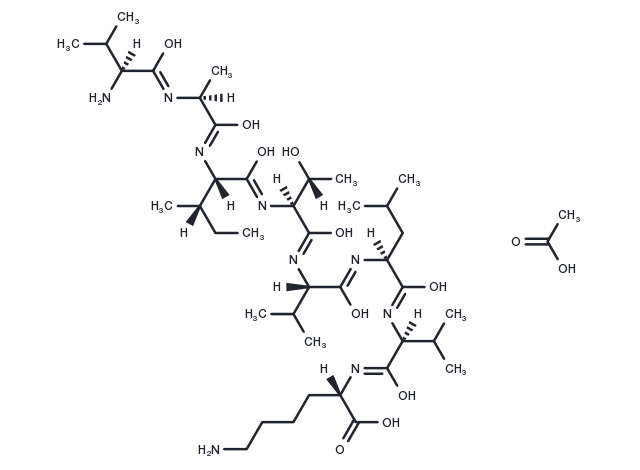keep away from moisture
Powder: -20°C for 3 years | In solvent: -80°C for 1 year

CALP1 acetate is a calmodulin (CaM) agonist (Kd of 88 µM) that binds to the CaM EF-hand/Ca2+-binding site. CALP1 blocks calcium influx and apoptosis (IC50 of 44.78 µM) by inhibiting the open of calcium channel. CALP1 blocks glutamate receptor channels and blocks a store-operated nonselective cation channel. CALP1 activates CaM-dependent phosphodiesterase activity.

| Pack Size | Availability | Price/USD | Quantity |
|---|---|---|---|
| 1 mg | In stock | $ 133.00 | |
| 5 mg | In stock | $ 302.00 | |
| 10 mg | In stock | $ 447.00 | |
| 25 mg | In stock | $ 738.00 | |
| 50 mg | In stock | $ 987.00 | |
| 100 mg | In stock | $ 1,380.00 |

| Description | CALP1 acetate is a calmodulin (CaM) agonist (Kd of 88 µM) that binds to the CaM EF-hand/Ca2+-binding site. CALP1 blocks calcium influx and apoptosis (IC50 of 44.78 µM) by inhibiting the open of calcium channel. CALP1 blocks glutamate receptor channels and blocks a store-operated nonselective cation channel. CALP1 activates CaM-dependent phosphodiesterase activity. |
| Targets&IC50 | Calmodulin:88 µM (kd) |
| Synonyms | CALP1 acetate(145224-99-3 free base) |
| Molecular Weight | 902.13 |
| Formula | C42H79N9O12 |
| CAS No. | TP1910L1 |
keep away from moisture
Powder: -20°C for 3 years | In solvent: -80°C for 1 year
You can also refer to dose conversion for different animals. More
bottom
Please see Inhibitor Handling Instructions for more frequently ask questions. Topics include: how to prepare stock solutions, how to store products, and cautions on cell-based assays & animal experiments, etc.
CALP1 acetate TP1910L1 Neuroscience CaMK CALP-1 Acetate CALP1 acetate(145224-99-3 free base) CALP 1 Acetate CALP1 Acetate CALP-1 acetate inhibitor inhibit
